Learn how to play 7 Card Stud Poker with our comprehensive guide. Get started on your journey to mastery with tips, tricks, and strategies that can help you win.
You're about to engage through one of the most strategic poker variants - 7 Card Stud Poker.
It's a game where patience, careful planning, and a keen sense of observation can give you a distinctive edge over your opponents.
This guide is written by none other than Ashley Adams, a pro poker player with years of experience under his belt. Ashley has spent countless hours at poker tables around the globe, using the strategies laid out in this guide to succeed at the game's highest levels.
He'll share his insights, lessons learned, and practical tips to help you understand the game's nuances and confidently play 7 Card Stud Poker.
In this guide, you will discover:
- What is 7-Card Stud?
- 7 Card Stud Poker Rules
- 7 Card Stud Poker Hands Explained
- Pro Tip: Remembering Exposed Cards and Using that Information in Play
- The Strategy for Each Betting Round
- Variations of Stud Poker
- "Wilder" 7-Card Stud Variations
- Expert Advice: Why Learn 7-Card Stud?
Let’s dive right in!
7-Card Stud is a variation of poker that has each player receiving a total of seven cards, from which they each make their best 5-card poker hand.
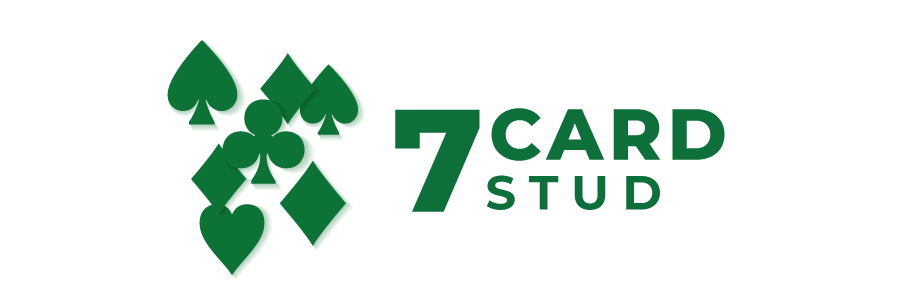
It was a variation developed in the late 1800s and popularized during the early and mid 20th Century, becoming especially popular during WWII as a somewhat wild alternative to 5-card Stud and 5-card draw, the dominant forms of the game until then.
7-Card Stud is different from Hold’em, the most common poker variety today, in that there are no common cards. Each player has a completely different hand. Also, unlike Hold’em, each player has exposed cards, that provide a window into their likely hand, and also provide information about what cards remain in the deck.
Typically, Stud is played limit, making it very different from the common no limit version of Hold’em. And, finally, 7-Card Stud has five betting rounds, instead of the four betting rounds of Hold’em.
7-Card Stud has many different variations including hi-lo, where the high hand and the low hand split the pot, and Razz, which awards the entire pot to the lowest possible 7-Card Stud hand. Each of those games will be briefly described at the end of this overview.
There are also many wilder versions of the game, popular in home poker games, including Baseball, Follow-the Queen, and Shrewsbury Stud.
7-Card Stud is played with a standard 52-card deck, with the standard ranking of cards from 2 to A. Players eventually receive seven cards, with which they make their best five card poker hand There are five rounds of the deal, called “streets”, each followed by a betting round.
Third Street: The First Betting Round
Each player is dealt three cards, one at a time, the first two face down, the third face up.
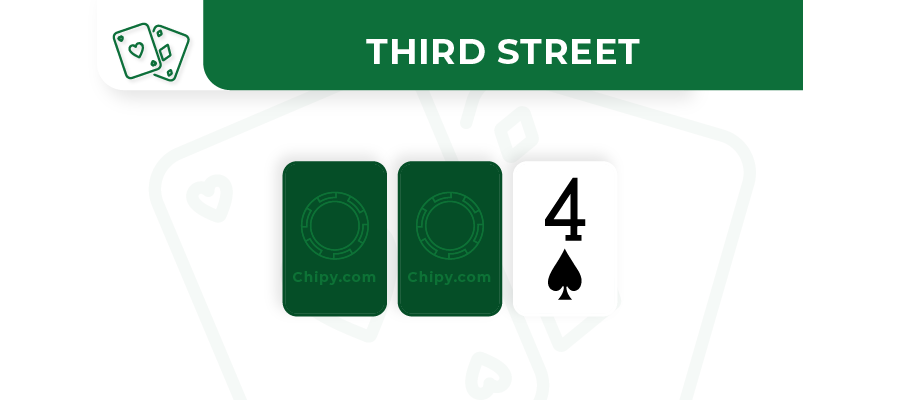
Betting commences with a forced bet from the lowest up-card.
Please note
If there is a tie between or among low cards, betting commences with the lowest suit (ranked from lowest to highest: clubs, diamonds, hearts, spades).
Fourth Street: The Second Betting Round
Each player who has not folded on third street receives a fourth card, dealt face up.
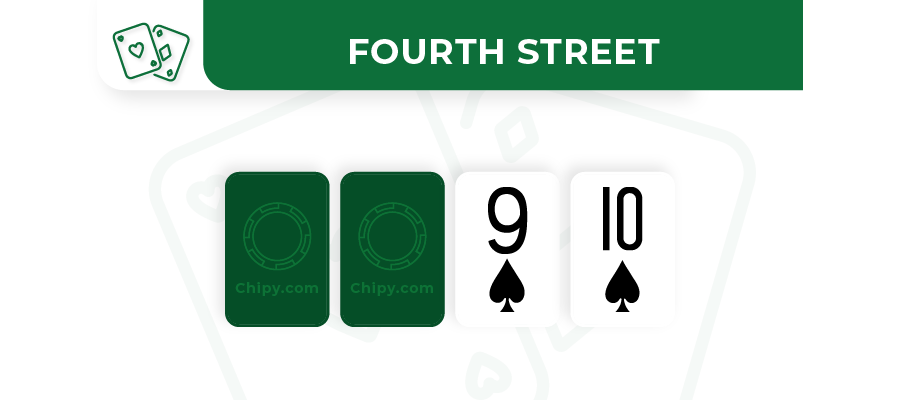
Betting starts with the player with the highest exposed hand.
Please note
If there is a tie, betting begins with the player closest to the dealer’s left.
Fifth Street: The Third Betting Round
Each remaining player receives a fifth card, dealt face up. Betting starts with the player with the highest exposed hand.
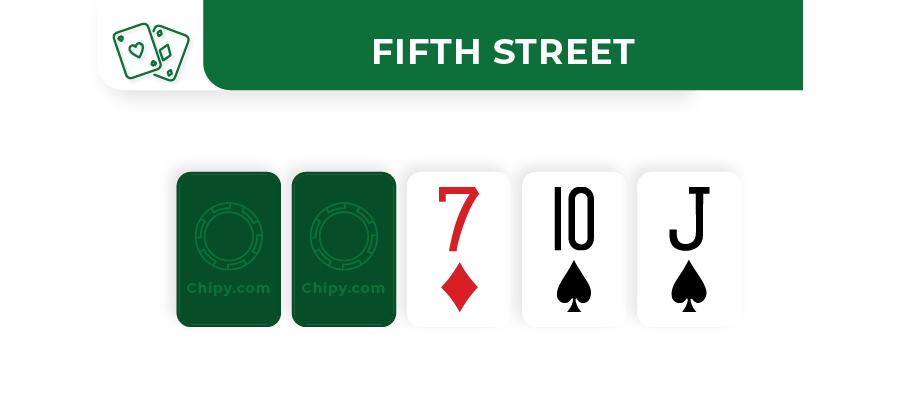
The betting size doubles.
For example
In a $20/40 Stud game, fifth street begins the $40 bets.
Sixth Street – fourth betting round
Each remaining player receives a sixth card, dealt face up.
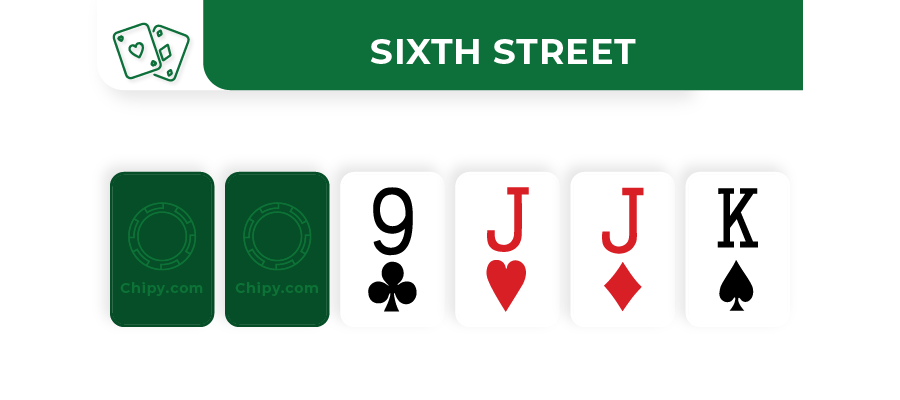
By this time, players have four exposed cards and two concealed cards. Betting starts with the player with the highest exposed hand.
The bet remains at the higher tier.
Seventh Street – also known as the River
Each remaining player receives a final seventh card dealt face down.

By this time, players have their complete hand of three down cards and four up cards.
Betting starts with the player with the highest exposed hand.
When the betting is completed, all remaining players (those who have not folded) reveal their hands, with the highest standard poker hand winning the pot.
Here is a diagramed hand of 7-Card Stud. For this example, we will illustrate a hand of $10/20 Stud, with a $1 ante and a $3 forced bet from the lowest card.
As a reference, these icons will be used to represent the player actions throughout each of the betting rounds:

Third Street Round
- Andy: (4h5h) 2c - $1 ante $3
- Fran: (Ac6h)7d - $1 ante calls $3
- Chris: (4c 6s)8s - $1 ante folds
- Bobby: (2d6d)Tc - $1 ante folds
- Cori: (2s6c)7s - $1 ante folds
- Zev: (5c5s)4d - $1 ante calls $3
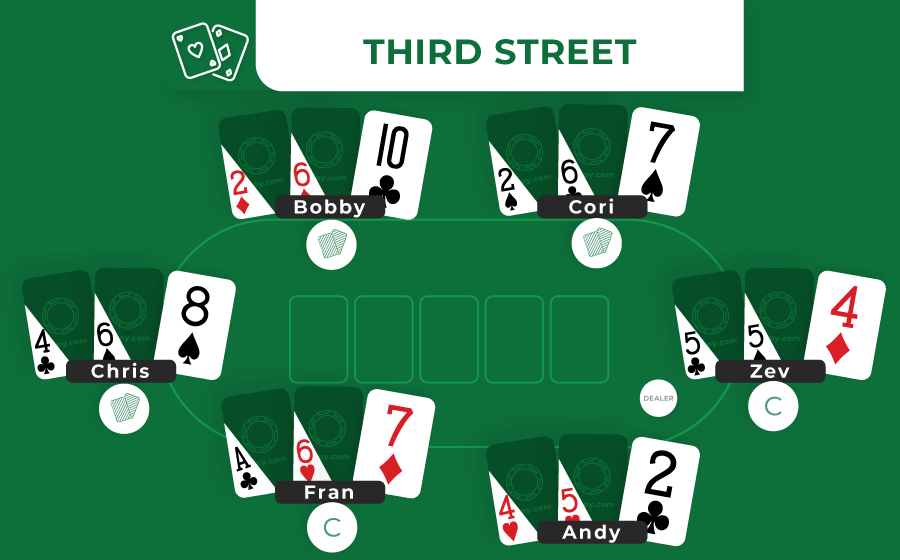
Pot is $15
Explaination
Each player antes $1. Andy is dealt a terrible hand, a 4 and 5 in the hole and a 2c door card. As the lowest exposed hand Andy must make the forced bet of $3. (He also has the option of making the complete bet of $10. But with such an awful hand he surely will not do so.)
Fran doesn’t have a very good hand either. But with an Ace in the hole, Fran calls the bring-in bet of $3.Chris has a terrible hand, and an 8 high. Chris wisely folds this turkey.
Bobby has a bad starting hand and correctly folds with a Ten high. Cori has a terrible holding, a 7 high, and correctly folds.
Zev has a concealed pair of 5s. Zev calls the bring-in bet.
With the six antes of $1, the bring-in, and two players calling the bring-in, and no one completing the bet to $10, the pot stands at $15.
Three remaining players: Andy, Fran, and Zev.
Fourth Street Round
- Fran: (Ac6h)7d7c - bet $10
- Zev: (5c5s)4dTh - calls $10
- Andy: (4h5h)2c2h - calls $10
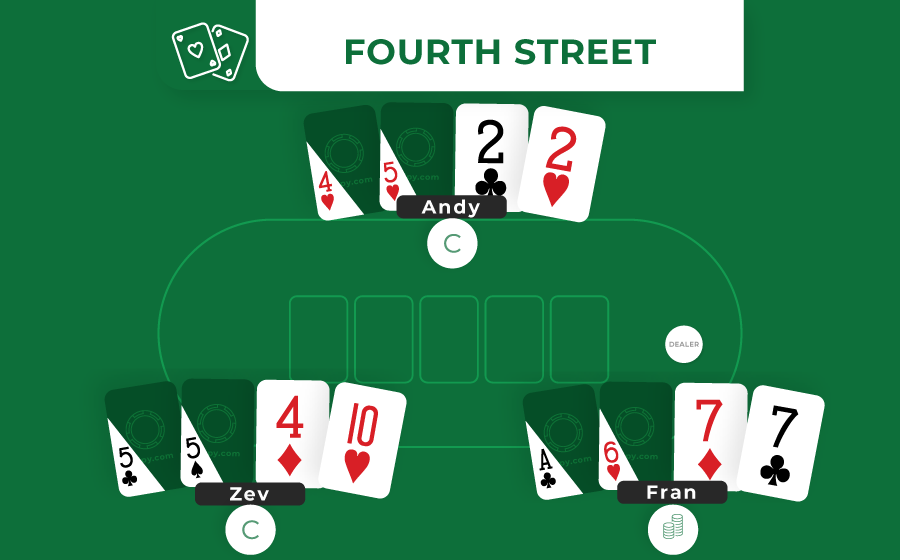
Pot is $45
Explaination
On fourth street the betting starts with the player with the highest hand. Fran has an exposed pair of 7s. With the highest hand, they have the option of checking (passing the bet to the next player), or either betting the lower or higher tier, in this game either $10 or $20.
They choose to bet the lower tier of $10. Zev, now with a Ten-high board and a pair of 5s in the hole, elects to call the $10 bet. Andy, with a pair of 2s, a 3-flush, and an inside straight draw, elects to call along as well. $30 is added to the $15 pot, making for a pot of $45 heading to fifth street.
Fran, Zev and Andy each get a third up card.
Fifth Street Round
- Fran: (Ac6h) 7d7c3h - check
- Zev: (5c5s)4dTh8c - check
- Andy: (4h5h)2c2hAs - check
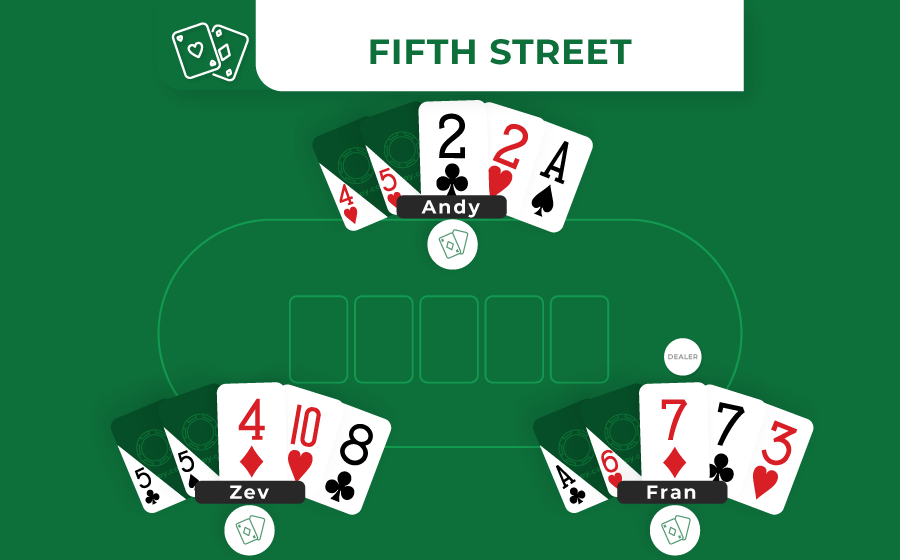
Pot is $45
Explaination
Fran does not improve, catching but a lowly 3, and checks. The bet passes to Zev.
Zev has not improved, still with just a pair of 5s. Zev checks. Finally, Andy gets a shot at opening the betting. With a pair of 2s and an open-ended straight draw (missing the 3), Andy elects to check as well. The round passes with no betting, keeping the pot at $45.
Fran, Zev, and Andy each get another card.
Sixth Street Betting Round
- Zev: (5c5s)4dTh8cTd - Bet $20
- Andy: (4h5h)2c2hAs3c - Raise to $40
- Fran: (Ac6h)7d7c3hAh - Call $40
- Zev: (5c5s)4dTh8cTd - Call $40
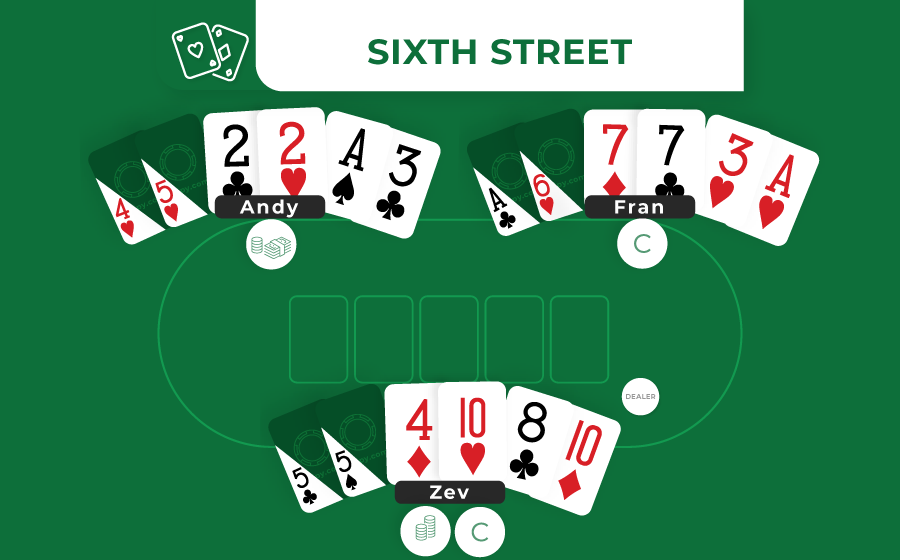
Pot is $165
Explaination
On this round Zev improves, hitting an exposed pair of tens to go with the hidden pair of 5s.
Zev bets $20. Andy hits his inside straight and raises to $40. Fran gets an Ace, making two pair, Aces up. Fran calls the raise. And Zev calls the raise as well.
All three players see the river card with the pot growing by $120 to $165.
River (Seventh Street)
- Zev: (5c5s)4dTh8cTd(9s) - Check
- Andy: (4h5h)2c2hAs3c(9c) - Bet $20
- Fran: (Ac6h)7d7c3hAh(Jc) - Call $20
- Zev: (5c5s)4dTh8cTd(9s) - Fold

Pot is $205
Explaination
Zev does not improve, getting the unhelpful 9s on the river. Zev checks.
Andy, with a straight, bets $20. Fran, still with Aces up, calls the $20 bet. Zev, seeing the bet and call and thinking he must be beaten, folds.
Andy, who bet, and Fran, who called, reveal their hands.
Andy, with a straight, specifically the lowest possible straight known as the “wheel” (5432A) beats Fran’s Aces over 7s Two Pair, and is awarded the $205 pot.
7-Card Stud is a skillful game, just like all other forms of poker.
It has one skill that isn’t necessary in Hold’em, Omaha, or draw poker; and that’s card memory. By keeping track of the folded cards, a sagacious player can better figure out the true odds of making their hand. They can also better estimate the likely holding of their opponents.
Remembering cards is a skill, developed over time and something that can be practiced away from the table.
As you work on your card memory, here are a few tricks of the trade for helping you:
1. Focus on only the folded cards
Some players, new to Stud, try to memorize every card they see. With as many as seven other players, and up to four exposed cards per player, memorizing every exposed card can be quite the memory feat. Instead, focus only on the cards as they are folded. Hey, the exposed cards are still staring you in the face. No need to memorize them!
2. Focus on remembering just the rank of the card
Hey, if you have an eidetic memory, go ahead and remember the suit and rank of every folded card. But for we mere mortals, that would truly be a difficult challenge. Instead, keep track of just the rank of each card without worrying about its suit.
Rather than remembering the 7h, just say the 7 to yourself as it is folded. In your head, make the list of those folded cards. It may help for you to remember them in numeric order, even if that wasn’t the order in which they were folded.
For example, imagine this is what you see around the table:
You get (Jd Js) As.
Now everyone makes their decisions:
- The 2h brings in the betting
- The Qh folds
- The Th calls
- You raise with your pair of Jacks with the Ace kicker.
- The 8h folds
- The Ks folds
- The 3c calls
- The 4d folds
- The 2h folds.
My recommendation
You say to yourself as the cards are folded: “Q, 8, K, 4, 2." If you think it helps, you can put it in numeric order and just keep repeating it to yourself KQ842. KQ842. KQ842. Like a mantra. If more than one card of a rank are folded just say the rank multiple times.
As cards are folded on later streets you can simply add them to your list and expand that mantra. With regard to suits, just initially look around the table and say to yourself any suits that have 2, 3, or 4 suits.
Don’t worry about memorizing it.
Just say, in this example, “three hearts”. As additional cards are folded just make a note of it. You’ll recall this subliminally – and it will come back to you if you need to decide whether you think someone is drawing for a flush. Of course, you want to remember all cards that are folded of your suit if you start with three suited cards and are drawing to a flush.
That’s it.
Rank of folded cards, mantra, general observation of suited cards. After a while it will be second nature.
We’ll look briefly at each street and the key strategy considerations for each. This is just a very brief survey of the strategy of the game. For more in-depth information you can check out Winning 7-Card Stud by this author.
Third Street Strategy
This is the most important street, as you are seeing 3/7th of your total cards. Mistakes on this street will be very costly. In general, if you aren’t sure whether to play your hand, err on the side of folding.
You will fold every starting 3-card hand unless it is one of the following. And you will not play all of the following hands either, as I’ll explain.
Fold on third street unless you have:
- Trips
- Pair
- 3-to-a-flush
- 3-to-a-straight
- Three Broadway cards (AKQJT)
Let’s look at each group, which hands you’ll actually play within each grouping, and how you’ll play them.
Trips
You will play all of your trips.
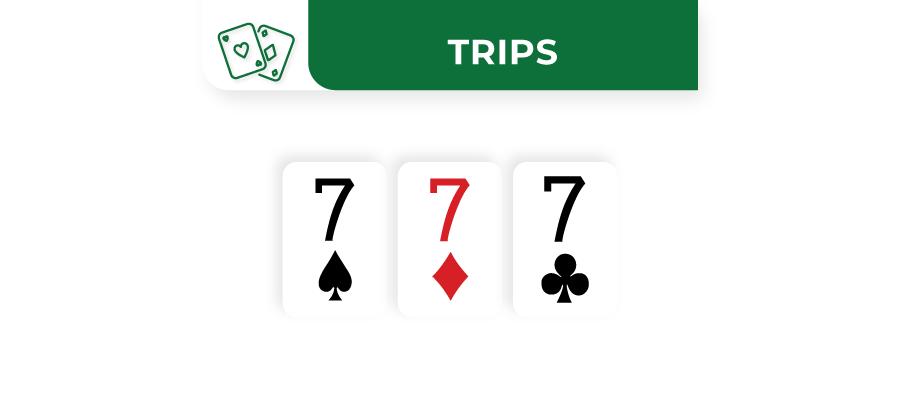
You will play this hand for a raise unless you believe that your raise will knock out all of your opponents, in which case you will only call.
Pair
You will limit yourself to playing premium pairs, TT or higher.

You may also play lower pairs with either an Ace or King kicker. You will raise with the premium pairs.
And, if you believe you have the highest pair, you will re-raise a raiser. With the lower pairs and the big kicker, you will generally call with these hands, though you may on occasion raise if you believe there is some chance that you will get everyone else to fold.
Generally, with a low pair and big kicker, you will need to pair your kicker in order to have the best hand.
You also want to pay attention to how “live” your hand is – that is how many of the cards that improve your hand are still unseen.
For example
You start with (77)A and you have seen a 7 folded and an Ace in front of another player, then of the 5 cards (two sevens and three Aces) that will improve your hand, 40% are unavailable. This weakens your holding considerably.
3-to-a-flush
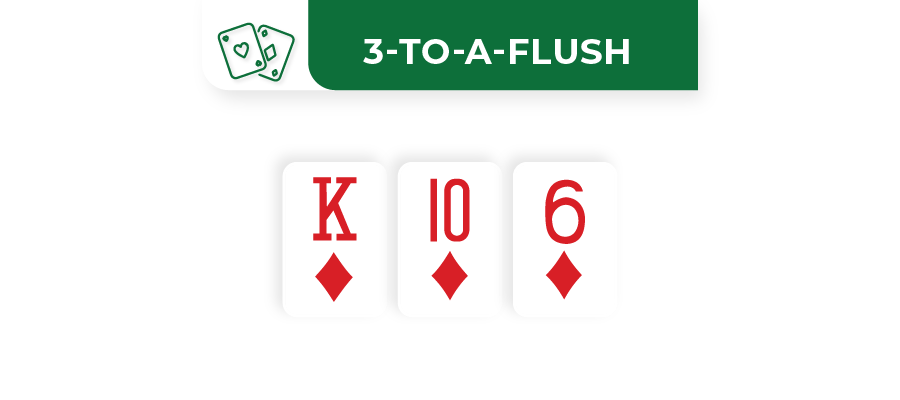
You want to play flushes headed by a premium card, ideally an Ace or a King.
You want to have two ways to win; either by making your flush or by improving to the best pair. What you want to avoid is starting with three suited low cards, making a low pair on fourth street, and feeling compelled to play on.
Down that route lies a lot of pain.
You also want to pay attention to how live your hand is. You typically should fold flush draws if there are three of your suit elsewhere exposed or folded.
Similarly, if your 3-flush is headed by a King, for example, you’d like to see no more than one King out. You generally want to fold your flush draw if there is a double bet (a completion and raise) in front of you.
3-to-a-straight
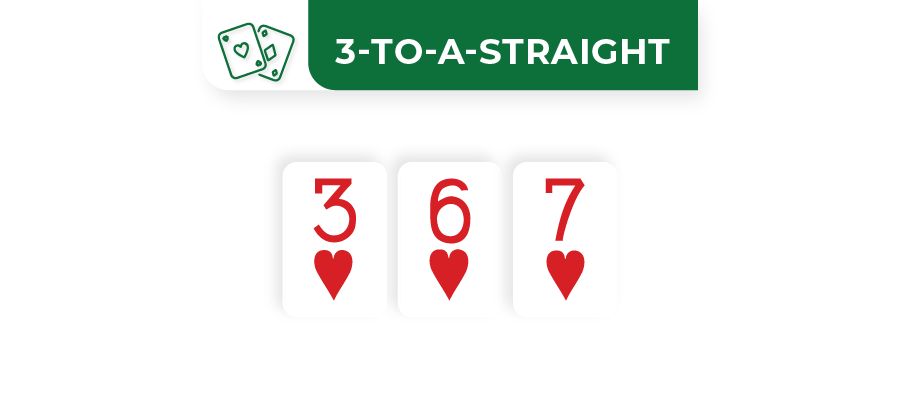
You wouldn’t be too far wrong if you decided not to play for straights at all. Straights lose to flushes and full houses.
And they’re more hard to make after third street than flushes. Even so, they can add some profit to your game, if you focus on only those 3-flushes that are the more likely to become winning hands.
Play 3-straights no lower than those headed by a Jack.
Play only 3 consecutive cards, without gaps. You can play a gapped 3-straight only if the bring-in isn’t raised – and isn’t likely to be raised after your call.
Only play 3-straights that are very live.
No more than 2 cards that could be useful in making your straight should be out.
For example
You may play QJT, but only if no more than two As,Ks,9s,or 8s are out. More than two and you are done.
Three Broadway Cards
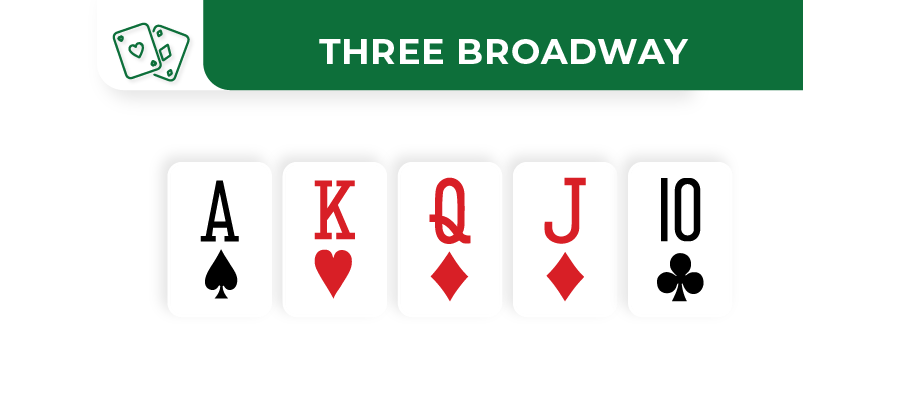
You can play three big cards, A,K,Q,J,T (known as Broadway Cards because they make up an Ace-high straight known as “Broadway”), but only if no more than two of the ranks you are holding are gone.
Otherwise fold this hand.
Fourth Street Strategy
I’m going to keep this extremely simple.
Though there are profitable opportunities on fourth street with drawing hands, even if they don’t improve, I recommend when you begin, that you bet and raise if you believe you are in the lead, and you fold if your flush or straight draw doesn’t improve.
One word of caution here
Yes, bet and raise if you believe you are in the lead. But be aware of the possibility, based on new cards and betting action, that you have fallen behind even if you started out in the lead on third street.
Here’s an example
You started with (K 9)K. You raised and were called by a 7 and a 3. On fourth street you saw the following:
You: (Ks 9c) Kd 6d
Bob: ( x x ) 7d Ac
Joe ( x x ) 3c 3d
Joe was high and checked. You raised with your pair of Kings
Bob re-raised. Joe re-raised with his pair of 3s.
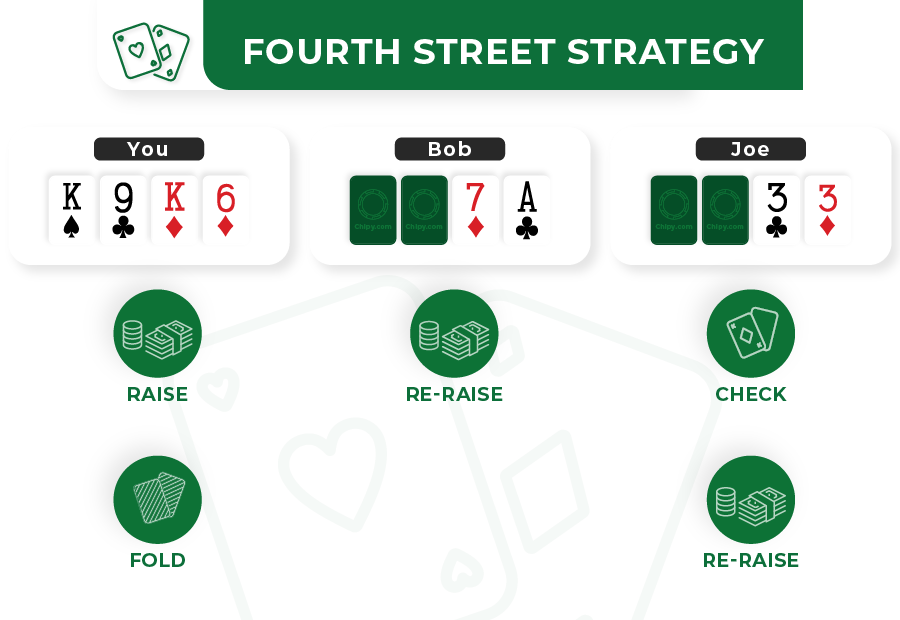
YOU SHOULD FOLD HERE!
Unless you are against raving maniacs, it’s fairly obvious what happened.
Bob had an Ace and maybe an A7 in the hole and has just hit either a pair of Aces or Aces up.
Joe has just hit trips and check raised to squeeze some extra money out of you both. You were likely to have started in the lead, but have just fallen into third place, and extremely unlikely to improve to a winning hand unless you hit one of the two Kings on the next hand. And even then you may well lose to a full house.
Don’t fall in love with your hand. Fold!
Fifth Street Strategy
This is the second most important decision point in this game.
Betting limits double. Most of the time, if you call on this street, you’re going to the river. So choose wisely.
Keep Betting in the Lead
Fifth street play is very hand specific, so it’s difficult to provide overarching strategy rules. Even so, the beginning and intermediate player is best to be guided by this conservative advice. Continue to be aggressive if you believe you are in the lead.
Don’t allow the possibility that you have fallen behind cow you into passivity.
You don’t want to give your drawing opponents a free card. If, for example, you have a pair of Kings, completed the betting on third street, and then lead the betting on fourth street; and now an opponent gets an Ace.
If they check, or if for some reason you have to decide on betting action before them, don’t check because you’re afraid they may have hit a pair of Aces or Aces up. Bet your hand. If they raise you can reassess and release.
But beware of being cowed by imagined monsters under the bed! Your failure to bet, giving opponents free cards, can be more expensive than betting.
Call with the Right Price, otherwise FOLD!
On the other hand, if you are drawing, with a flush or a straight draw, continue to do so if you are getting the right price. Figure out your pot odds and your drawing odds. If your drawing odds are worse than your pot odds you must fold. Make sure to consider how many cards are left that can make your hand.
If the cards you need to make your hand are largely dead, fold to a bet. If they are very much alive, and if the pot is big enough, continue to draw.
Now is the time to fold if you’re not getting the right price.
Important
“Keep hope alive!” is a good slogan for a political campaign, but very dangerous at the poker table.
Sixth Street Strategy
For the most part, the pot is large enough and the pot odds great enough at this stage that if you called on fifth street you should usually call on sixth street.
There are some exceptions, however. If your opponent’s cards and their betting action are such that you think they have a hand that you are unlikely to beat even if you improve, go ahead and fold to a bet.
Here is an example
You have been calling since third street with a flush draw, and your opponent gets exposed trips. Fold to a bet. True, they may have been betting without a pair on third street. They may only have the trips you observe. But they are probably full already, meaning you’ll lose even if you hit your flush on the river.
And even if they’re not full, they have many ways of making a full house on the river, beating you even if you hit your roughly 4 to 1 shot at a flush.
Fold to a bet.
Here's another example
You are drawing for a flush – a Queen-high flush as it turns out. Another player also seems to be on a flush draw, a King-high flush judging by his board. He’s been checking and calling a bet from a third player who appears to have a pair of Aces, based on his completion on third street and his lead betting on fourth and fifth street.
Now it’s sixth street. The Ace pairs one of his small board cards.
Your opponent, sitting between the bettor and you, raises. You can go ahead and fold your flush draw. First of all, you have to call a double bet (a bet and a raise), with the possibility of a re-raise and another re-raise after you call. Second, you are drawing against what looks to be a made flush, better than the one you can make.
Get out. Yes, maybe this is an elaborate bluff, but it’s more likely you are drawing dead.
Seventh Street a.k.a the River Strategy
The general guidance on the river is to bet if you think you are ahead and call unless you are darn near certain you’re beaten. In any closer situations you must call because of the enormous pot odds you are getting.
With three concealed cards on the river, just about any hand is possible for your opponent.
But don’t let that scare you into folding to a bet when you have a chance of holding the winner. If there is a reasonable, even if improbable chance that your hand will win you must call.
Look at it this way
You are faced with either making a small mistake with an errant call or a huge one with an errant fold. Here’s an example.
Playing $10/20, with a pot of $350 on the river, you are facing a $20 bet from your opponent who has been betting with a Jack door card since third street.
You were drawing to a Queen-high flush and just hit a second Queen on the river, busting your flush, and giving you exactly one pair of Queens.
Your opponent is a fairly conservative player.
Since he bet the river, you think that in all likelihood, he hit at least two pair – probably Jacks up. Otherwise, you surmise, he would have checked.
You’re thinking of folding.
Don’t fold! You should almost surely call.
This is a situation of either making a small mistake or a huge one.
If you call incorrectly, and he does in fact have two pair or better, and you lose, then you have made a small mistake. The extra call on the river, when you should have folded, will cost you $20. It seems like a bigger mistake because you called, you exposed your hand, you only had a pair of Queens, and YOU LOST.
They pushed the whole $370 pot to your stinking opponent. But the call itself was only a $20 mistake.
On the other hand, if you fold incorrectly, and he only has a pair of Jacks and would have lost to your Queens if you had called him, then the mistake costs you the pot of $350! That’s a HUGE MISTAKE!
Don’t make huge mistakes on the river when you can make small ones.
7-Card Stud Strategy Summary
Bet ‘em when you get ‘em; call with the right price; and keep track of the folded cards to best estimate your drawing odds and your opponent’s likely hand.
7-Card Stud has been around since the late 19th century. During that time, players have created many alternative games.
Below is a brief list of some of the more popular variations, with a brief explanation of each.
Razz (7-Card Stud Low)

Razz (short for “razzle-dazzle”) inverts the standard ranking of hands, with the lowest hand winning.
Aces are low cards. Straights and flushes don’t count. The best possible hand is A2345, known as the wheel. Other good hands are 6 lows and 7 lows.
Razz poker is rarely spread as a game unless it is part of a mixed game like HORSE, with R standing for Razz. The key is to play only three starting cards 8 or lower, and to bet your board – your exposed cards – to convince opponents to fold.
7-Card Stud Hi-Lo

This is surely the most common variation. It combines regular Stud with the low version of the game known as Razz, awarding half the pot to the person who wins high and half to the person who has the worst hand.
This game, itself, has a few variations, one of which is commonly spread in public poker rooms.
We’ll look at that one first. 7-Card Stud hi-lo with an 8 qualifier for low.
Stud 8, as it is known, is dealt exactly like 7-Card Stud, but the pot is awarded differently. In 7-Card Stud, the pot is awarded to the high hand. But in Stud 8, the high hand gets half and the qualifying low hand gets low.
To qualify, the low can be no higher than an 8.
Following the conclusion of the last betting round, remaining players reveal their hands.
The highest hand and the lowest qualifying hand divide the pot. If no remaining player has an 8 low or better, the entire pot is awarded to the high hand.
The strategy is generally to play for low – as a low hand can back into a high (typically a flush or a straight.)
But the high hand cannot generally back into a low. So low hands are often free-rolling against a high hand. The Ace is especially valuable as it can serve both as a low and a high card.
The casino game is played “cards speak”, there being no declaration of high or low.
Flushes and straights do not count against a low in the public poker room game; and, thus, the wheel (A2345) is the best low.
Pro Tip
Avoid playing the game as if it were both a high game and a low game. It isn’t. You want to scoop the pot, not win one half or the other.
Good starting hands are three babes (cards that make a wheel), A pair of Aces with a babe, or three suited low cards.
7-Card Stud Hi-Lo Declare

This is a home game variant.
The game is dealt and bet exactly like 7-Card Stud. The difference is that after the last card is dealt, and the last bet called, players have to declare whether their hand is competing for high, for low, or for both.
Players declaring high cannot win low. Players declaring low cannot win high. Players declaring both must either win or tie in both directions or they lose completely. (Some home games require that players win in both directions outright – and if they tie in either direction they lose).
Declarations may be made consecutively, starting with the highest exposed hand, or made simultaneously. When there is a simultaneous declaration players place one, two, or three chips in their hand. They then simultaneously open their hands, revealing 1, 2, or 3 chips.
If they reveal one chip they are going low, two chips high, and three chips both ways.
Some home games consider flushes and straights to count against the low. In those games the 6-4-3-2-A of different suits is the best low hand.
Betting After the Declare
After the declare, some games just award the pot to the best declared high and the best declared low, with no further betting.
Other games have another betting round after the declare.
Some add restrictions to that betting round, to limit the betting of someone going one way (known as the “lock”), against two or more people going the other way.
Make sure you know the house rules before you find yourself facing a pot-sized bet from someone declaring low when you’re competing against someone for high.
Here are 3 wild variations of the game you can play:
Follow the Queen (Queens and After)

This has the Queen as a wild card. It also deems a wild card that card (and all of its rank) that is dealt immediately after the last exposed Queen.
With 8 potential wild cards in play, the value of the winning hand can be extremely high.
5 of a kind is not uncommon.
Baseball

Threes (strikes) and Nines (innings) are wild. If you get a 4 (a walk) you get an extra card.
Some games tax the player who gets the extra cards. Others make the wild cards match the pot if they wish to continue in the game. The extra wild cards greatly inflate the value of the winning hands.
5 of a kind is not uncommon.
Shrewsbury Stud

4 common cards are added to the game. The final down card is omitted.
The common cards, when added to the six individual cards, give each player ten cards with which to make a 5 card poker hand. It is typically played hi-lo. Winning high hands will usually be a full house or higher, with quads not unheard of.
There may well be two or more perfect lows.

7-Card Stud is not nearly as popular in public card rooms as it was before the vast interest in Hold’em starting in the early 21st century. Some may wonder why it still makes sense to learn the game.
There are 2 reasons chiefly:
- 7-Card Stud and its low and hi-lo variation are still regularly spread in private games. Since few people learn the game today, your knowledge will give you a leg up on much of the opposition. You’ll be able to hold your own against the old guard who came up playing the game; and you’ll be able to dominate the Hold’em players who are still trying to still trying to figure out this 7-Card game.
- 7-Card Stud and its low and hi-lo variations are still spread in public card rooms, especially in tournaments, as part of mixed cash games and tournaments. They form three of the five letters in the mixed game of HORSE, half of the two games in OE, two of the four games in H.O.S.E., R.O.S.E or S.H.O.E. Being proficient in those games will give you an opportunity to win in what can be juicy mixed games.
Final Thoughts
There you have it - the complete guide on how to play 7-card stud poker.
Now you're ready to hit the table with style!
And remember, knowledge of more than one game gives you the opportunity to take advantage of good games wherever they may be. When you’re done learning about 7-Card Stud here, make sure to learn about no limit Hold’em, Hold’em, draw, and Omaha in other parts of the Poker Academy.

Bonuses
Casinos
Games
Academy
News
Shop
NEW Q&A
Sweepstakes












































